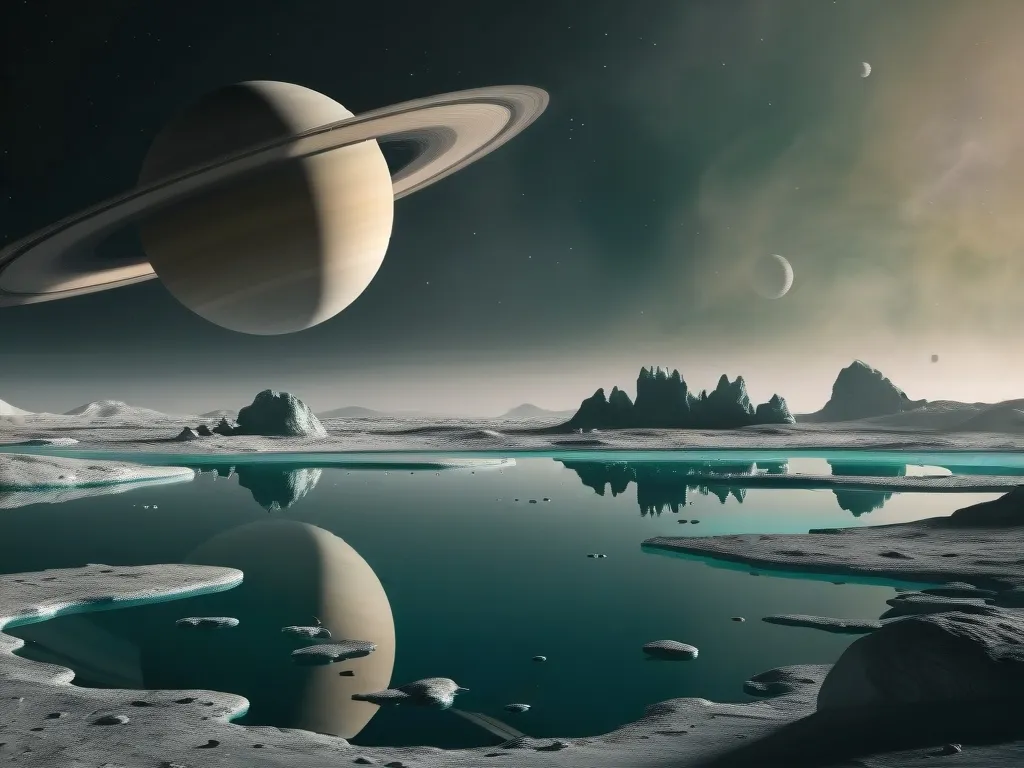As we venture into the vast expanse of our solar system, there are few places as fascinating and enigmatic as Titan, the largest moon of Saturn. For many, Titan is more than just a celestial body; it’s a world that sparks imagination and fuels conspiracy theories. Let’s delve into the intriguing idea that Titan might be more than just a natural satellite – could it be an alien outpost hiding in plain sight?
The Enigmatic World of Titan
Titan is unlike any other moon in our solar system. It’s larger than Earth’s moon and even the planet Mercury, and it boasts a dense atmosphere, primarily composed of nitrogen and methane. This atmosphere is so thick that it obscures the surface, making Titan a mystery until the arrival of NASA’s Cassini spacecraft in 2004. The images and data from Cassini and the Huygens probe revealed a world with Earth-like features – riverbeds, vast deserts, and hydrocarbon lakes. These lakes are the first open bodies of liquid found anywhere in our solar system besides Earth, but they are filled with liquid methane, not water.
The surface of Titan is a harsh environment, with temperatures plummeting to minus 289 degrees Fahrenheit and pressures akin to being at the bottom of a swimming pool. Yet, despite these extreme conditions, Titan’s landscape is eerily familiar. The rocks here are made of water ice, and the lakes flow with liquid methane, creating a scenario where a single spark could ignite the entire moon.
The Conspiracy Theories
Conspiracy theorists often point to Titan as a potential alien outpost, citing various reasons that range from the moon’s unique environment to alleged signals and communications. One of the key arguments is that Titan’s atmosphere and surface features are too complex to be natural, suggesting that some form of intelligent life might be at play.
For instance, some theorists argue that the methane lakes and seas on Titan could be evidence of biological activity. While scientists explain these features through geological and chemical processes, the idea that life could exist in such a form is tantalizing. Researchers at Cornell University have even modeled a hypothetical life form, called an “azotosome,” which could theoretically exist in Titan’s methane-rich environment. However, this life form would be nothing like what we imagine – it would be microscopic and based on nitrogen and methane rather than oxygen and water.
Signals and Communications
Another aspect that fuels the conspiracy theories is the alleged interception of signals from Titan. While there is no credible evidence to support this claim, it has become a staple in many conspiracy narratives. The idea is that these signals could be evidence of extraterrestrial communication, and that NASA or other space agencies might be withholding this information.
However, the reality is that the data we have from Titan comes from rigorous scientific missions like Cassini-Huygens. These missions have provided a wealth of information about Titan’s atmosphere, surface, and potential for life, but none of it suggests any form of intelligent communication.
NASA and the Truth
The notion that NASA is hiding something about Titan is a common theme in conspiracy theories. But the truth is that NASA and other space agencies are transparent about their findings. The Cassini mission, for example, was a joint project between NASA and the European Space Agency, and all the data collected during its 13-year journey around Saturn has been made public.
Scientists are indeed fascinated by Titan and continue to study it because of its unique environment and the insights it provides into the formation and evolution of our solar system. The exploration of Titan is not about uncovering alien secrets but about understanding our own planet better. By studying Titan, scientists can gain valuable insights into Earth’s own atmosphere, geology, and potential for life.
The Future of Titan Exploration
As we continue to explore our solar system, Titan remains a prime target for future missions. The European Space Agency and NASA are planning new missions to explore Saturn’s moons, including Titan, in the coming decades. These missions aim to uncover more secrets about Titan’s surface, atmosphere, and potential for life.
For example, the proposed ESA mission to Enceladus, another moon of Saturn, highlights the scientific community’s interest in these celestial bodies. Enceladus, with its geysers of water and organic compounds, is considered a prime candidate for hosting life. While this mission is focused on Enceladus, it underscores the broader interest in exploring the moons of Saturn for signs of life and to understand the complex chemistry and biology that could exist there.
Personal Reflections
As I delve into the mysteries of Titan, I am struck by the sheer wonder of this alien world. It’s a place where the rules of Earth do not apply, where methane rains from the sky and lakes are filled with a substance that would be toxic to us. Yet, despite its alien nature, Titan feels strangely familiar – a reflection of Earth in a distant, icy mirror.
The conspiracy theories surrounding Titan are intriguing, but they also distract from the real science and wonder of this moon. Titan is not an alien outpost but a natural wonder that challenges our understanding of the universe and encourages us to explore further.
In the end, the allure of Titan lies not in its potential as an alien base but in its ability to inspire us to explore, to question, and to seek answers about the mysteries of our solar system. As we continue to venture into the unknown, Titan stands as a beacon, reminding us of the wonders that await us just beyond our reach.






